- from 750,000 to 400,000 years ago (Acheulean and early Clactonian);
- from 400,000 to 200,000 years ago (Acheulean and Middle Clactonian);
- from 200,000 to 40,000 years ago (Acheulean and recent Clactonian, and Mousterian);
- from 40,000 to 12,000 years ago (Upper Paleolithic).
The typology of the sculptures is constituted by numerous types of bicephalic anthropomorphic heads. These heads are without necks.
In the Lower Paleolithic, sculptures are of small dimensions and are represented as looking in opposite directions (Fig. 5.2). At the end of the Lower Paleolithic, in the Mousterian, there are smaller ones (Fig 5.35), and bigger ones ( Fig. 5.24), up to the weight of about 88 lbs, and with the orientation of the look, that is of the head, in every direction.
Between 200,000 and 12,000 years ago, this type of sculpture was realized in a remarkable variety of styles, from the very realistic, with real proportions, to some elongated forms. Moreover, one head can be smaller than the other to which it is combined.
In the Paleolithic no sculptures of bicephalic anthropomorphic heads with a body have been found, but some very small statues have been found from the Upper Paleolithic that I will describe with the Venuses.
In the Upper Paleolithic there are no paintings showing bicephalic human heads. The bicephaly is found in sculpture in historic civilizations and in small primitive civilizations.
In the Lower Paleolithic, bicephalic anthropomorphic sculpture often represents in the same sculpture two hominid heads of different species, and this coincides with skeletal findings of different hominids that have co-existed, that have been found in Africa.

Found in a cave by W.I. Eitzman in 1925. First described by R. Dart in 1974.
Height: 2 inches.
Origin: Makapansgat (valley of the Northern Province, South Africa).
Absolute dating: 3,000,000 years (Dart) and 2.5 - 2.9 million years (Bednarik).
Find studied by Raymond Dart, Mary Leakey, and Robert G. Bednarik.
Material culture: not defined, but the use of accidental cutting stones is established.
(Drawing deduced from a drawing by R.G. Bednarik.)
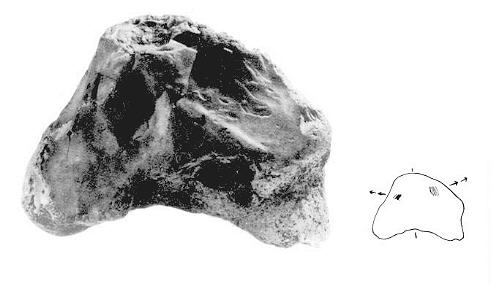
Fig. 5.1) Bicephalic anthropomorphic stone sculpture. It represents two hominid heads joined at the neck, looking in opposite directions. The head on the left side is in the line of Homo habilis, while the head on the right represents a more modern hominid, probably in the line of a pre-Homo erectus or a pre-sapiens. The sculpture is obtained from a nodule of flint and can be considered of good workmanship for the epoch.
Height: 2 inches.
Origin: Rodi Garganico, Foggia, Italy.
Material culture: probable transition between Oldowan and ancient Clactonian.
Collection of the Museum of the Origins of Man.
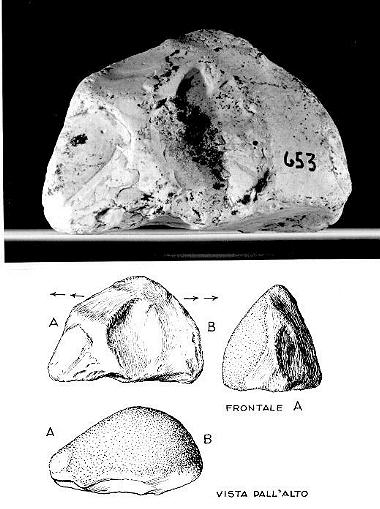
Height: 2 inches.
Origin: Rodi Garganico, Foggia, Italy.
Material culture: probably a transition between Oldowan and ancient Clactonian.
Obtained from a flint pebble; the sketched-out part is greater than the unsketched part (see dots in the drawing). Under the jaws of the two heads there is a hollow some millimeters deep, deliberately made to highlight the shape of the jaw. The sculpture has traces of alluvial rolling but is not disfigured.
Collection of the Museum of the Origins of Man.
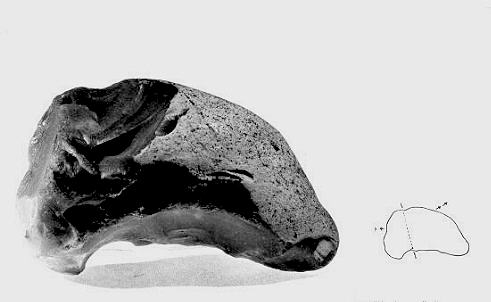
Length: 2.7 inches.
Origin: Rodi Garganico, Foggia, Italy.
Material culture: probable transition between Oldowan and early Clactonian.
The larger head is lengthened for stylistic deformation, but it is evident that the hominid species represented is more modern. Four other sculptures with the same cultural attribution have several typological affinities. Three sculptures can be compared (Fig. 5.1 - 5.4 - 5.6) that have this in common: 1) one head larger than the other; 2) the larger head is elongated; 3) a part is hollowed upwards to show the union of the jaws of the two heads; 4) two different species of hominids are represented; 5) the smaller heads are all oriented to the left. The fourth sculpture (Fig. 5.5), collected by J. BOUCHER DE PERTHES, has two heads of equal dimensions, oriented differently than the other four sculptures, but with the same two types of hominids.
Collection of the Museum of the Origins of Man.
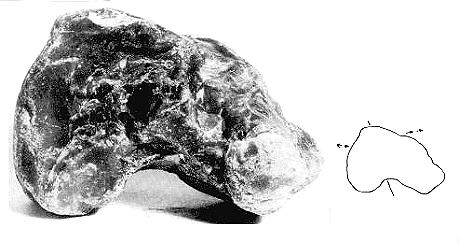
Height: 3.1 inches.
Origin: Gela, Caltanisetta, Sicily, Italy.
Material culture: probable transition between Oldowan and early Clactonian.
Collection of the Museum of the Origins of the Man.

It represents two hominid heads of different species joined at the neck.
Material culture: probable early Acheulean.
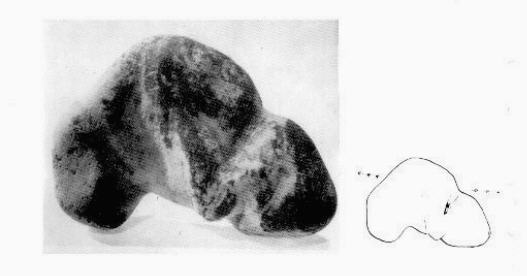
Length: 3.3 inches.
Origin: Tortona, Alessandria, Italy.
Material culture: probable a transition between Oldowan and early Clactonian, or early Clactonian.
Collection of the Museum of the Origins of Man.
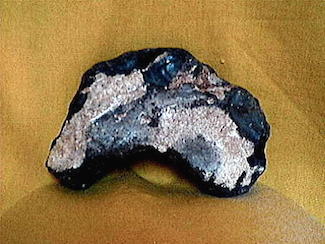
Collection of the Museum of the Origins of Man.
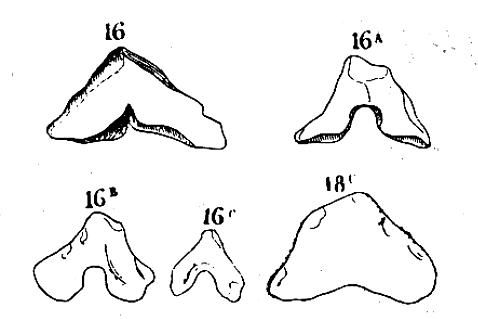
They are representations of human heads joined at the neck, looking in opposite directions, and are bicephalic anthropomorphic sculptures. They are all typical. The material used is flint.
The stylistic deformation is of various types, proof that they originate in different periods of the Lower Paleolithic.
Boucher de Perthes's interpretations were varied, and different from the current typology.
Size: from 2 to 5.1 inches long.
Technique of working: it isn't analyzed; however, sculptures nos. 16 and 16a seem not to have rounded edges, while the other three sculptures seem to have slightly rounded edges from alluvial tumbling.
Origin: "Alluvial sands", probably of the Valley of the Somme.
Material culture: Early or Middle Clactonian. All the sculptures collected by Boucher de Perthes are in large part authentic, and those that aren't, that are errors, re-enter in the margins of error, made also by other researchers, along with the stone tools and the fossil human remains of the first half of the 18th century.
Boucher de Perthes died at 80 years of age in 1868. The ferocity of his enemies did not cease: in 1869, in the name of official science, his works were sent for pulping.
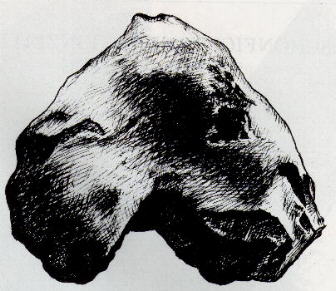
The sculpture represents two hominid heads joined at the neck looking in opposite directions. Obtained from a nodule of flint. The eye is constituted by a natural hole; the sides most worked are in the zone from the nose to the front part of the jaws, and the hollows that join under the two jaws towards the top. The human types are archaic, that is hominids with absence of forehead and chin; however, from a drawing it is not possible to establish if the features are those of Homo erectus or archaic Homo sapiens.
Juritzky thought this sculpture represents two joined heads, but of ferocious animals. The statement can be explained by the fact that, half a century ago, there was not yet the knowledge we possess today about skulls of hominids found in Africa. In his typology of bicephalic heads, using the hollows under the jaws, Juritzky made a geometric distinction measured in degrees.
Length: probably 8 7.8 inches long.
Technique of working of the flint: hollowing, with little refinement.
Origin: probably central northern France.
Material culture: Acheulean or Middle Clactonian
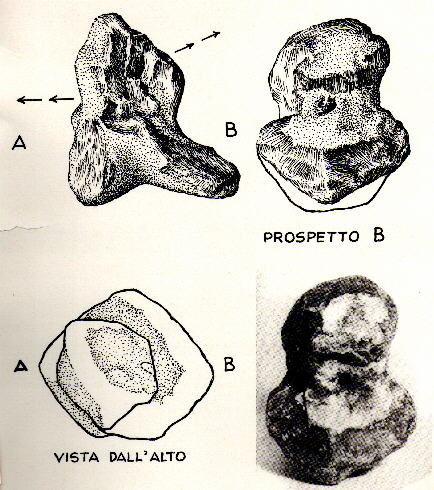
The white side in the photograph is the crust of the nodule. In the drawings it is represented with dots. In the photograph a natural hole is examined (the zone of the mouth) that was increased by removing the crust.
Height: 3.1 inches.
Origin: Gela, Caltanisetta, Sicily, Italy.
Material culture: Early Clactonian.
Collection of the Museum of the Origins of Man.
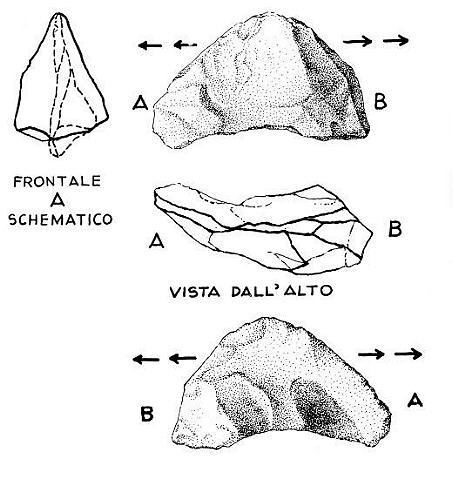
Length: 2.9 inches.
Origin: Rodi Garganico, Foggia, Italy.
Material culture: Early Clactonian.
It represents a human species similar to those described in the previous photographs.
The stylistic deformation, in this representation, tends to horizontal elongation. This sculpture is in flint, and worked on every side. This type of sculpture has been occasionally found by paleoethnologists who remain rigorously unaware of this type of art. They however have understood that these were artifacts, therefore some have considered them "œprocessing waste" while others, more "enlightened", understood they were "intentional artifacts", as they did not have cutting edges like the processing waste, and considered them "useless tools"! In the studies of prehistory it happens also that some scholars make illogical interpretations, perceiving humans as making "useless tools".
Collection of the Museum of the Origins of Man.
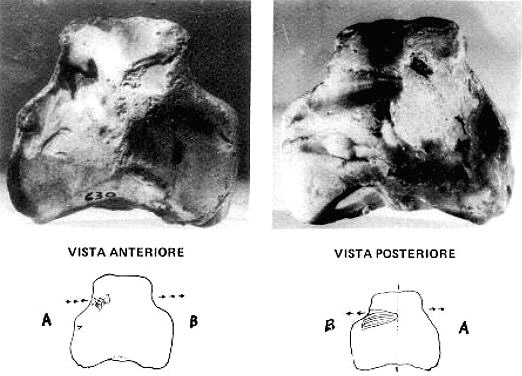
Height: 2.1 inches.
Origin: Romandato river, Rodi Garganico, Foggia, Italy.
Material culture: Early or Middle Acheulean. The attribution of Acheulean is based, also, on the similar type of workmanship of the Acheulean hand axe or biface, chipped on one side and then turned and chipped on the other side.
Collection of the Museum of the Origins of Man.
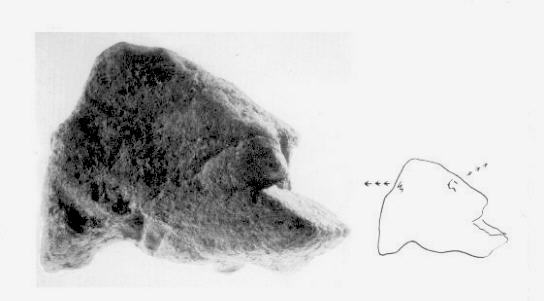
Height: 3.5 inches.
Origin: Vesima, Genoa, Italy.
Material culture: Acheulean or Early or Middle Clactonian.
Collection of the Museum of the Origins of Man.
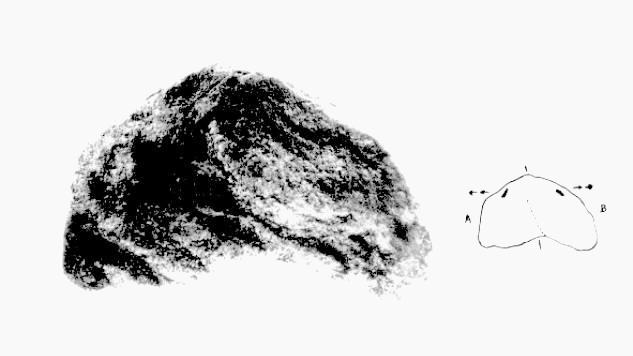
Length: 8.6 inches. Width: from 1.5 to 2 inches.
Origin: Cave of the Olive Tree, Valle del Vero, Toirano, Savona, Italy.
Material culture: Acheulean or Early or Middle Clactonian.
The Cave of the Olive Tree was uncovered during excavations for the Spanish mission in Italy in 1958, in the Chalcolithic and Bronze Age levels. In the excavated material from these digs, deposited outside the cave, this sculpture was found. It is in local grey stone covered with a coating of white limestone approximately .07 inches thick that demonstrates the long time it was in the cave; it also establishes that the sculpture was carried into the cave for cult rituals. This would be the first finding of a sculpture in a European cave dating to the Lower Paleolithic.
Collection of the Museum of the Origins of Man.
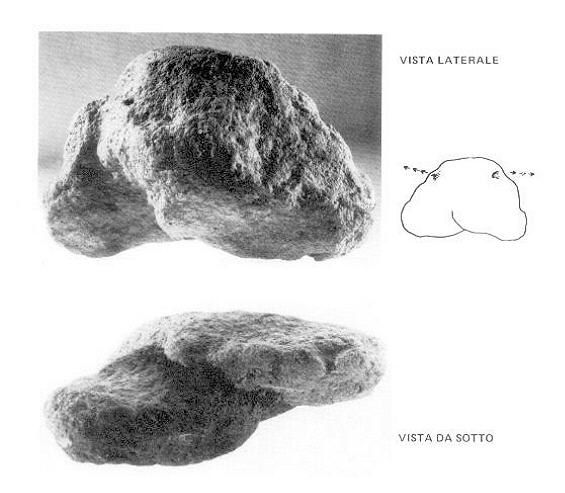
Length: 3.3 inches.
Origin: Venosa, Potenza, Italy.
Material culture: Middle Clactonian.
Collection of the Museum of the Origins of Man.
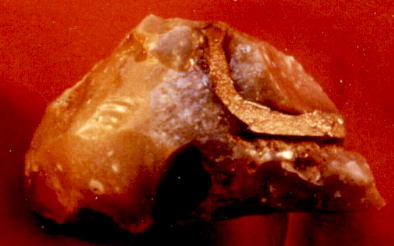
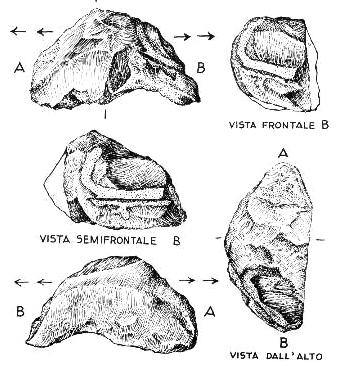
Length: 3.3 inches.
Origin: Rodi Garganico, Foggia, Italy.
Material culture: Clactonian or Middle or Late Acheulean.
Collection of the Museum of the Origins of Man.
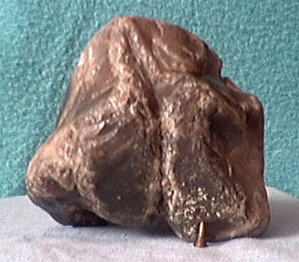
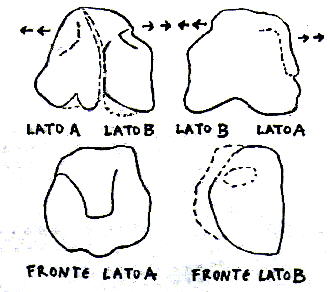
Height: 3.3 inches. Width: 4.1 inches.
Origin: Maribo, Denmark.
Material culture: Clactonian or Middle or Late Acheulean.
A study with seven photographs and drawings entitled : " A bicephalic anthropomorphic stone sculpture of the Lower Paleolithic of Denmark " by P.Gaietto, 2001, is published in Paleolithic Art Magazine.
Collection of the Museum of the Origins of Man.
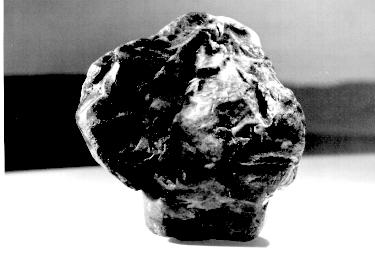
Height: 1.7 inches.
Origin: Caramanico, Pescara, Italy.
Material culture: Clactonian or Middle or Late Acheulean.
Collection of the Museum of the Origins of Man.
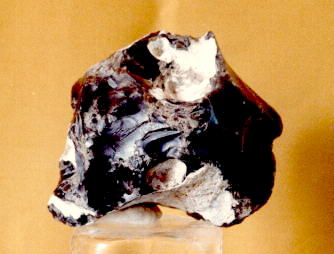
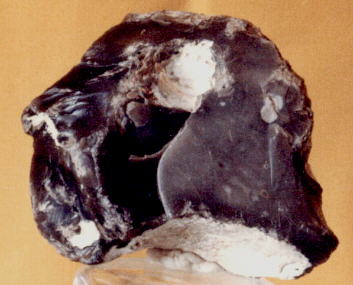
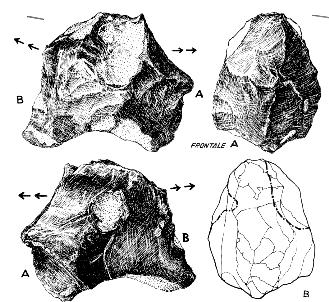
Fig. 5.19) Bicephalic anthropomorphic stone sculpture representing two hominid heads joined at the neck, of different species. (Fig. 5.19.1 rear). This sculpture is stylistically proportioned. It is similar to the sculpture of Gela (Fig. 5,4) because of its two human types, but also to many other sculptures. In this sculpture the head side (B) (see drawing 5.19.2) has the chin, while the attached head does not have a chin, and has a rounded face. It is the only sculpture of the Lower Paleolithic that represents this human type with the NOSE; and this makes one think that in other sculptures of this type it was omitted, as the ears were also not represented.
The sculpture is obtained from a flint nodule on which the original crust remains; it is white in color. In the drawings this is indicated by dots. It has only slight signs of alluvial transport, which are not disfiguring.
The other sculpture from Maribo (Fig. 5,17) is much more painstaking in its details, and the style tends toward vertical elongation; however, the head side B is similar to the sculpture in Fig. 5.9.2, side B. Three human species (or varieties) are represented in these two sculptures from Maribo.
Length: 4.3 inches.
Origin: Maribo, Denmark.
Material culture: Clactonian or Middle or Late Acheulean.
Collection of the Museum of the Origins of Man.
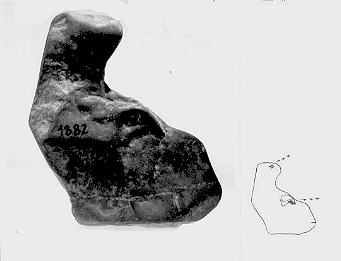
It's possible, however, that the small head is actually a ritual headdress or hairstyle.
Height: 4.3 inches. Thickness: from 1.9 to 3.1 millimeters. Red silex.
Origin: Senigallia, Ancona, Italy.
Material culture: Mousterian or pre-Mousterian.
Collection of the Museum of the Origins of Man.
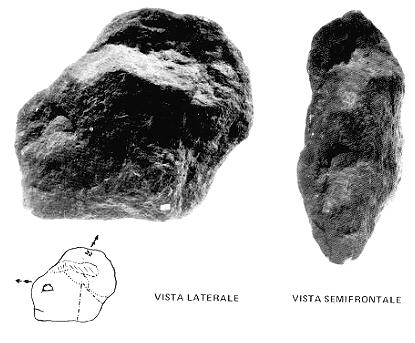
Height: 9 inches.
Origin: San Pietro d’Olba, Savona, Italy.
Material culture: Mousterian.
Collection of the Museum of the Origins of Man.
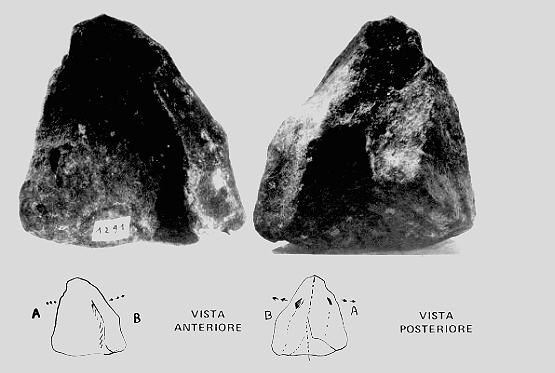
Height: 4.1 inches.
Origin: Frosinone, Italy.
Material culture: Late Acheulean or pre-Mousterian.
Collection of the Museum of the Origins of Man.

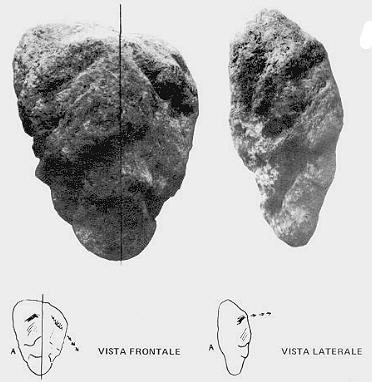
This sculpture represents two Homo sapiens neanderthalensis. The head on the right, oriented to look downward, certainly has a special meaning. The Mousterian was a theater of great inventions in sculpture, as the matchings in the bicephalic sculptures are varied and of different types. However, most of the combinations are repeated and are types that correspond to certain periods of the Mousterian, and also to different geographical areas. It is to be pointed out that the assignment to the Mousterian is usually based on the representation of Homo sapiens neanderthalensis, but some sculptures could be precedent, and others posterior, attributed to the Upper Paleolithic.
Height: 11.8 inches.
Origin: Voltri, Genoa, Italy.
Material culture: Mousterian.
Collection of the Museum of the Origins of Man.
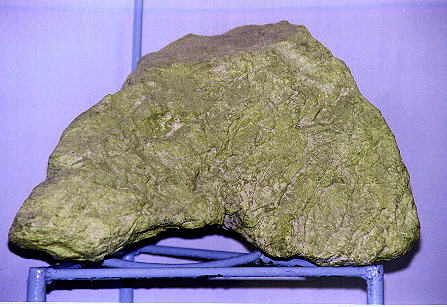
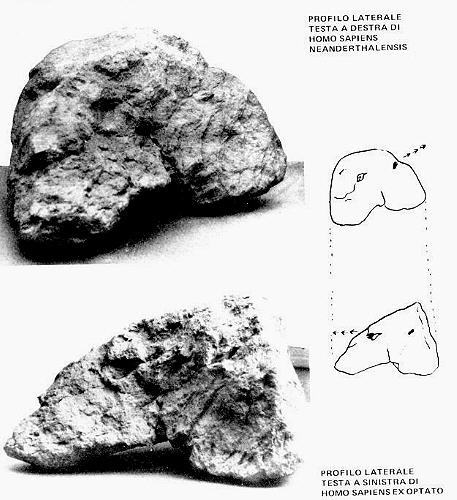
Length: 17 inches.
Origin: Campoligure, Genoa, Italy.
Material culture: Mousterian.
Collection of the Museum of the Origins of Man.
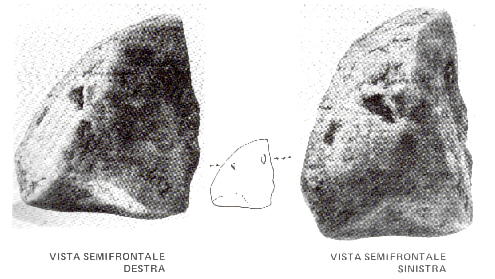
The head on the left represents a Homo sapiens neanderthalensis. The eye is formed by a triangular hole. The head on the right represents a Homo sapiens sapiens and has the forehead, nose and chin represented, and the eye that is constituted by a circular incision.
Height: 1.9 inches.
Origin: San Severo, Foggia, Italy.
Material culture: Mousterian.
Collection of the Museum of the Origins of Man.
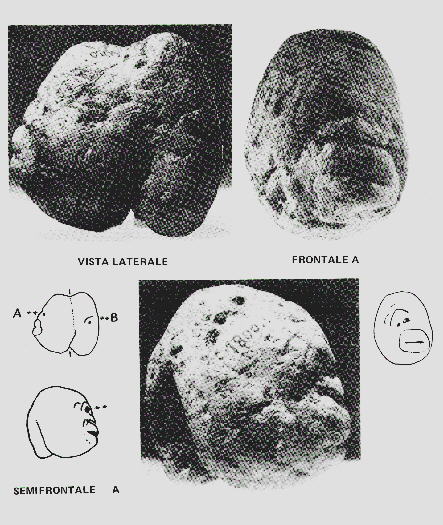
The sculpture is in green stone; it has suffered alluvial tumbling, but is not excessively damaged. The technique of working is of two types: sculpture and incision. The head on the left has represented the eye, nose and big lips. These big lips are also present in a Mesolithic deity and in a Celtic one(Fig. 5A8 - 6A1). The head on the right has represented the eye with an engraving.
Height: 1.9 inches.
Origin: Monte Gazzo, Genoa, Italy.
Material culture: Mousterian or Upper Paleolithic.
Collection of the Museum of the Origins of Man.
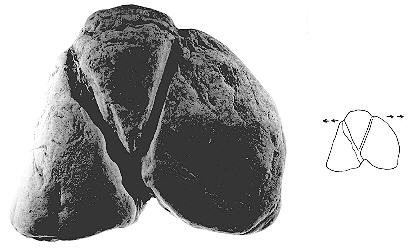
We find an affinity with this sculpture, regarding the combinations of the two styles and of the two working techniques, in the zooanthropomorphic sculpture (Fig. 9.8) found in the Cave of the Children (Balzi Rossi).
Height: 10.6 inches.
Origin: Andora, Savona, Italy (a mountain village on the coast a short distance from the Balzi Rossi caves).
Material culture: Mousterian.
Collection of the Museum of the Origins of Man.
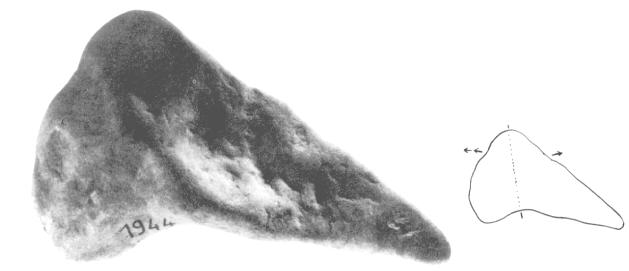
Length: 5.7 inches.
Origin: Fidenza, Italy.
Material culture: Mousterian (previous or later). In the Mousterian, it is likely that some cultures, in certain areas, were more advanced than others. These differences are found in all the post-Paleolithic epochs, and still exist today. It follows that in sculptures like this and others which have been found on the surface, the cultural attribution, that is, the relative dating, is difficult to establish.
Collection of the Museum of the Origins of Man.
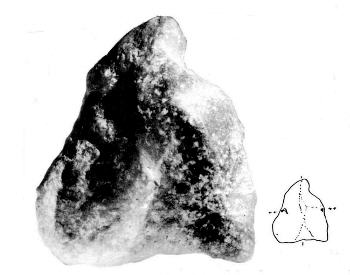
The sculpture is obtained from fragments of stalagmite.
Height: 1.9 inches.
Origin: Cave of the Basura, Toirano, Savona, Italy.
Material culture: Mousterian or Upper Paleolithic.
Collection of the Museum of the Origins of Man.
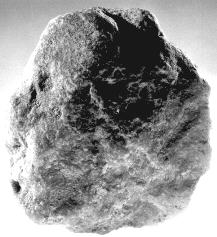


Height: 1.9 inches.
Origin: the Basura cave, Toirano, Savona, Italy.
Material culture: Mousterian or upper Paleolithic. At the time of discovery, about 45 years ago, this cave excited great interest in the media due to the discovery of footprints and handprints (in the hardened clay) purported to be those of Neanderthal Man. Recently, new studies have prevailed for the attribution of the fingerprints to Homo sapiens sapiens. However, the presence of Homo sapiens neanderthalensis is ascertained from the small sculptures, like this one, which represent it. Collection of the Museum of the Origins of Man.

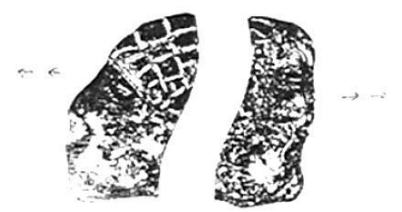
Height: 1.5 inches.
Origin: Balzi Rossi, Imperia, Italy. (Balzi Rossi is a complex of caves on the Mediterranean sea coast of Italy, at the border with France.)
Material culture: Mousterian or Upper Paleolithic (probably Aurignacian).
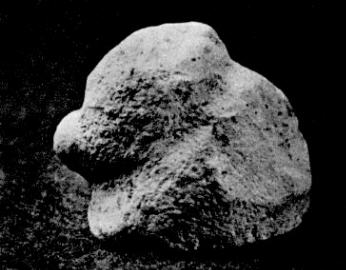
The opinion of the discoverer is different from our opinion, in how much he thinks that the sculpture is a "stylized animal".
Size: Base .07 inch.
Origin: Kostjenki, Russia.
Material culture: for the discoverer, Gravettian; for us, final Mousterian.
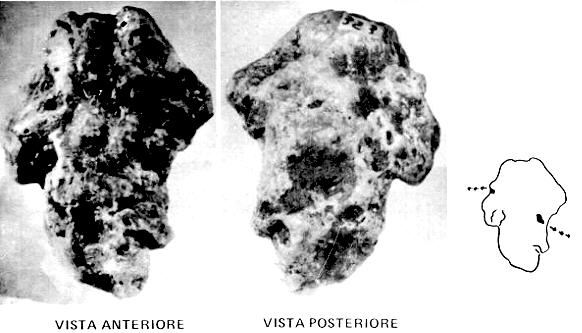
Height: 2.7 inches.
Origin: the Basura cave, Toirano, Savona, Italy.
Material culture: Mousterian or Upper Paleolithic.
Collection of the Museum of the Origins of Man.
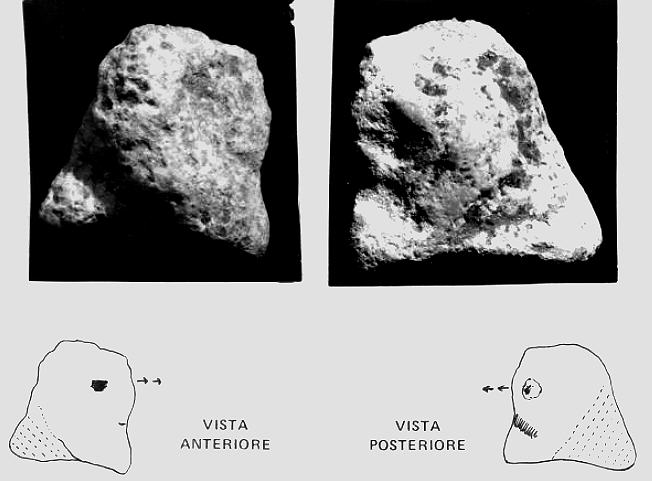
Height: 1.5 inches.
Origin: the Basura cave, Toirano, Savona, Italy.
Material culture: Mousterian or Upper Paleolithic.
Collection of the Museum of the Origins of Man.
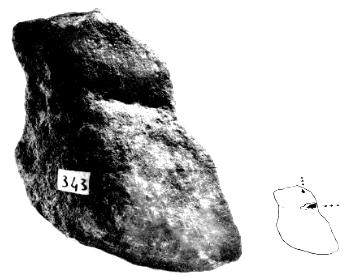
Length: 5.1 inches.
Origin: Palo, San Pietro d'Olba, Savona, Italy.
Material culture: Mousterian or Upper Paleolithic.
Collection of the Museum of the Origins of Man.
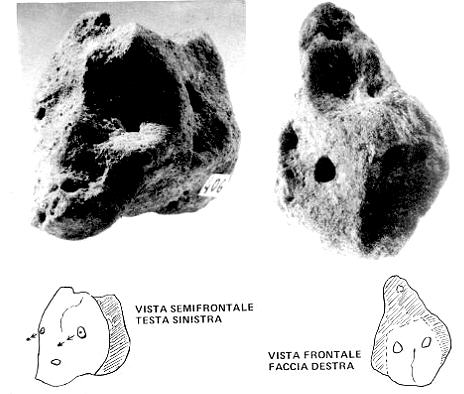
The sculpture is in red travertine, and besides being sculpted, it is modeled by scraping, and the eyes and mouth are obtained with scraping by twisting.
Length: 3.5 inches.
Origin: Borgio Verezzi, Savona, Italy. (A mountainous zone on the coast of the Mediterranean sea.)
Material culture: Upper Paleolithic.
Collection of the Museum of the Origins of Man.
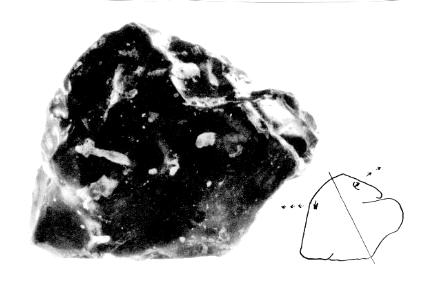
Height: 2.2 inches.
Origin: Senigallia, Ancona, Italy.
Material culture: Upper Paleolithic.
Collection of the Museum of the Origins of Man.
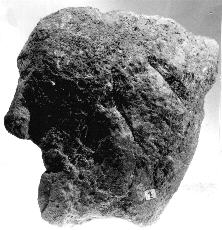
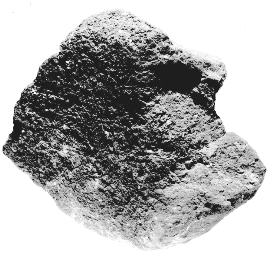
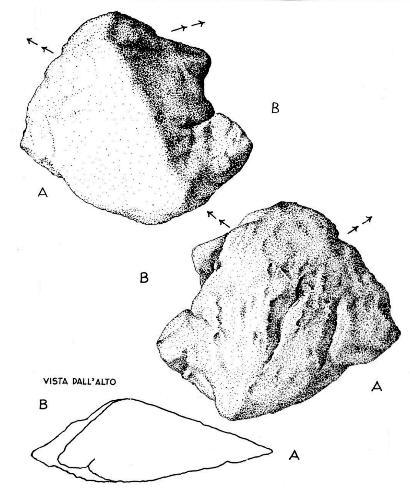
Fig. 5.40) Bicephalic anthropomorphic stone sculpture representing two heads of Homo sapiens sapiens joined at the neck.
- Fig. 5.40 the left head is of acromegalic type, probably a male; on the right is a feminine head or that of a young person. This head is well modeled, with cheek in relief, but behind it is flat.
- Fig. 5.40.1 back of the sculpture. On the left the female or young person's head is not represented, and we can see only the profile with chin. The head on the right is complete in the face: nose, eye, mouth and chin. This head is not frontal, but the representation is from the two sides (it is the only one known from the Paleolithic) and is a prelude to the all-round representation of the head of post-Paleolithic ages.
Height: 7.01 inches.
Origin: San Pietro d'Olba, Savona, Italy.
Material culture: Upper Paleolithic.
Collection of the Museum of the Origins of Man.
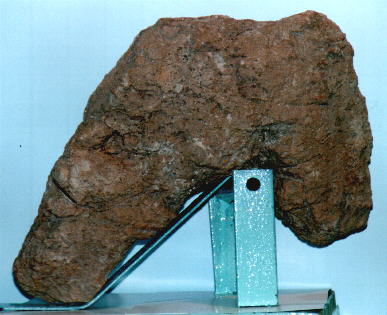
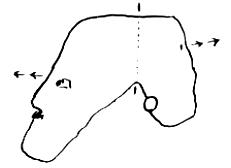
Length: 16.5 inches.
Origin: Rossiglione, Genoa, Italy.
Material culture: Upper Paleolithic.
Collection of the Museum of the Origins of Man.
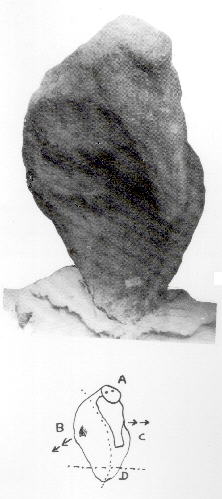
There are two hypotheses on the use of this sculpture in rituals: it could be placed horizontally on the ground, as it is flat on the back, or placed upright with the end (D) in the ground, in such a way that the head on the left looks downward while the head on the right looks forward. This is the only bicephalic anthropomorphic sculpture we know of with a human figure applied. A similar type of human figure (head and body) is found joined to the head of a mammal in the sculpture from Palo (Fig. 9.10 ).
Height: 17.7 inches.
Origin: Rossiglione, Genoa, Italy.
Material culture: Upper Paleolithic.
Collection of the Museum of the Origins of Man.
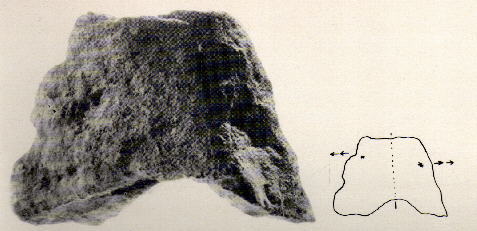
Height: 2.3 inches.
Origin: Tiglieto, Genoa, Italy.
Material culture: Upper Paleolithic.
Collection of the Museum of the Origins of Man.
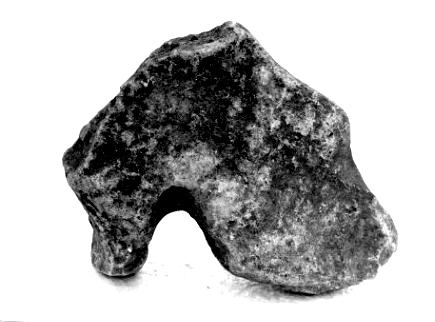
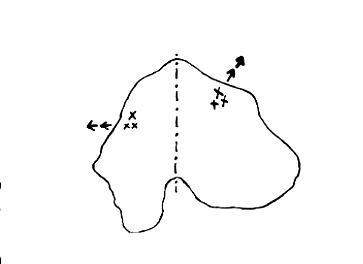
Length: 8.6 inches.
Origin: Pian Castagnè, Lessini mountains, Verona, Italy.
Culture material: Upper Paleolithic.
Collection of the Museum of the Origins of Man.
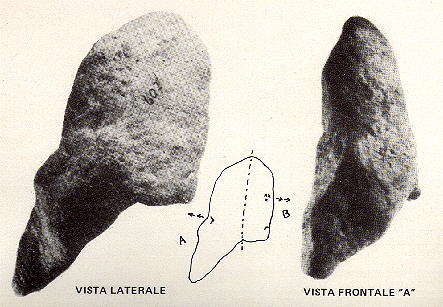
Height: 4.7 inches.
Origin: Rossiglione, Genoa, Italy.
Material culture: Upper Paleolithic.
Collection of the Museum of the Origins of Man.
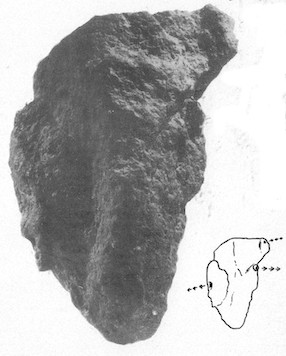
The bicephaly also encompasses sculptures that have three and four heads, or multiple faces in a single head.
Height: 5.5 inches.
Origin: Palo, San Pietro d'Olba, Savona, Italy.
Material culture: Upper Paleolithic.
Collection of the Museum of the Origins of Man.
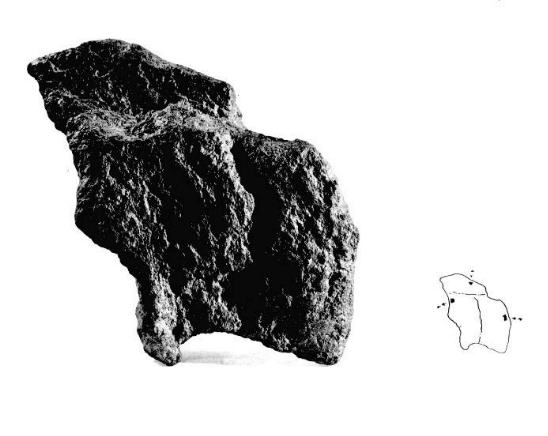
It has a distant affinity with a bicephalic zoomorphic sculpture on bone representing three horses looking in three different directions (Fig. 11.2) and of three different "ages": colt, adult horse and skull of horse.
Height: 5.1 inches.
Origin: Tiglieto, Genoa, Italy.
Material culture: Upper Paleolithic.
Collection of the Museum of the Origins of Man.
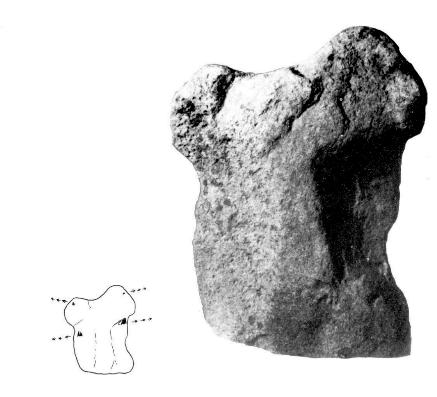
Height: 7.08 inches. Width: 1.18 inches.
Origin: Saint Feliù, Brava Coast, Spain.
Material culture: Upper Paleolithic.
Collection of the Museum of the Origins of Man.

Height: 5.8 inches (low figure 2 inches; high figure 3.7 inches).
Origin: Gagarino, Russia.
Material culture: Upper Paleolithic (according to L.M. Tarassov).
Page translated from Italian into English by Paris Alexander Walker.
Copyright©2020 by Museum of the Origins of the Man, all rights reserved.